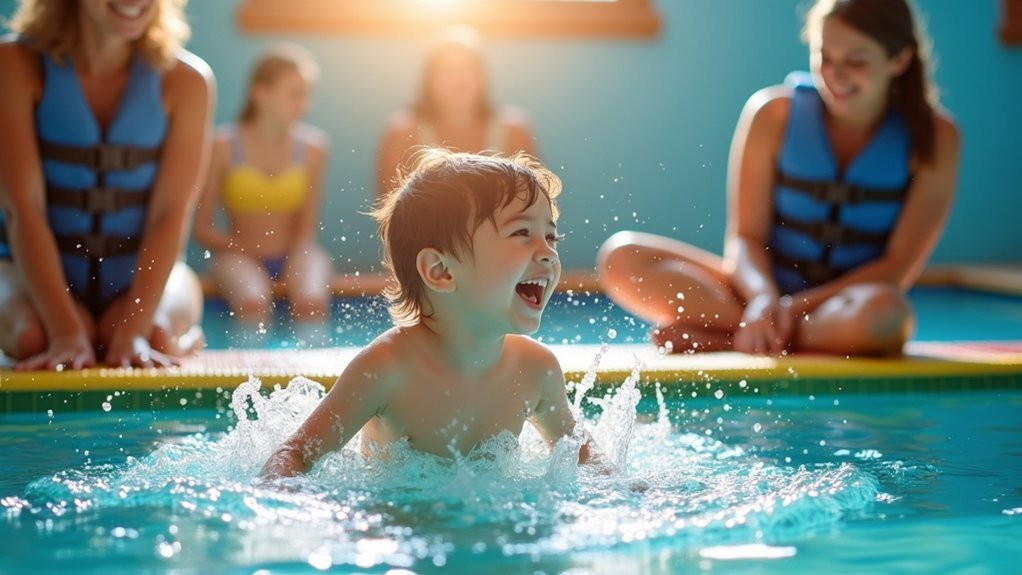Sensory Splash Therapy uses water’s unique properties to engage multiple senses simultaneously while promoting healing. You’ll experience tactile stimulation through buoyancy, auditory input from flowing water, and visual engagement with ripples. This aquatic approach helps children with autism, cerebral palsy, and developmental delays by building core strength, reducing muscle spasticity, and fostering social connections. The therapy can be adapted for home use with proper supervision and equipment. Discover how this therapeutic play might transform your or your child’s development journey.
The Sensory Symphony: How Water Engages Multiple Senses

Why does water create such a profound impact on our sensory experience? It’s because water simultaneously activates multiple sensory systems in a way few other elements can. When you dip your hands into water, you’re engaging with a full sensory symphony.
Tactilely, water’s buoyancy reduces gravity’s constraints while providing varied textures through splashing or using sponges.
Aurally, the sounds of flowing water offer dynamic auditory input that improves processing skills.
Visually, sparkling ripples and reflections enhance tracking abilities and spatial awareness. The shimmering patterns created by water movement provide visual cues that naturally attract attention and promote sensory integration.
Proprioceptively, water’s resistance provides continuous feedback about your body’s position, improving coordination and motor skills.
This multi-sensory engagement explains why water therapy is particularly effective for those with sensory processing challenges – it creates a thorough sensory environment that both calms and stimulates.
Building Core Strength Through Buoyancy: A Foundation for Movement
Your core muscles find their perfect training partner in water’s natural resistance, creating a dynamic environment that challenges stability with every movement you make.
You’ll experience enhanced neuromuscular control as underwater resistance training engages multiple muscle groups simultaneously, all while the buoyancy reduces joint strain. This approach to training enhances balance and stability while protecting your joints from excessive impact.
Aquatic support systems, from specialized flotation equipment to customized immersion techniques, allow you to progressively build core strength that transfers effectively to land-based activities.
Underwater Resistance Training
Building strength in water takes on an entirely new dimension compared to traditional land exercises.
You’re working against 800 times more density than air, creating natural resistance that engages your core from all directions simultaneously.
Unlike weights that provide constant resistance, water’s resistance increases with your movement speed, allowing you to adjust intensity without changing equipment.
This multi-directional resistance forces your core to stabilize continuously, improving balance and posture while reducing injury risk.
You’ll find exercises like Swiss ball sits, isometric core crunches, and wood chops with HydroTones particularly effective.
The water’s buoyancy supports your joints while still challenging your muscles, making these exercises accessible regardless of fitness level.
This combination of resistance and buoyancy creates an efficient workout environment where you can build strength with less stress on your body.
Many swimmers incorporate unilateral glute bridges in their training regimen to enhance power transfer through their core while performing swimming strokes.
Aquatic Support Systems
Aquatic support systems transform how we comprehend core strength development by leveraging water’s unique buoyant properties. Your body’s autonomic nervous system naturally engages core muscles while stabilizing in water, creating an ideal environment for strengthening without conscious effort. The gentle water pressure enhances neuromuscular control during stability exercises, creating more effective training outcomes.
You’ll find water exercises particularly beneficial if you’re recovering from injury or managing joint conditions, as the buoyancy reduces stress on vulnerable areas while still promoting strength development.
| Equipment | Benefit |
|---|---|
| Aqua boards | Enhances balance challenges |
| Noodles | Supports challenging postures |
| Trampolines | Increases core activation |
| Flotation devices | Enables progressive training |
| Ledges/benches | Adds exercise variability |
These systems offer customizable workouts that can be adapted for any fitness level, integrating traditional exercises like Pilates or yoga into the water environment for maximum therapeutic benefit.
Therapeutic Applications of Aquatic Play for Diverse Needs

Water therapy offers remarkable versatility in addressing the unique needs of children with various conditions and abilities.
Whether your child has autism, cerebral palsy, Down syndrome, or is recovering from an injury, the aquatic environment provides a supportive medium for healing and development.
The water embraces all abilities, creating a nurturing space where every child can heal, grow, and thrive.
- Children with autism find calm in the gentle, consistent pressure of water against their skin, reducing sensory overload while encouraging social interaction.
- For those with cerebral palsy, the buoyancy effect reduces muscle spasticity, allowing freedom of movement that’s impossible on land.
- Kids recovering from sports injuries can rebuild strength through resistance exercises without putting stress on healing joints.
You’ll notice improvements in motor skills, sensory processing, and emotional well-being as your child progresses through tailored aquatic therapy sessions.
Children with developmental delays benefit from the therapeutic play-based activities that make skill acquisition more engaging and effective than traditional therapy settings.
Creating Social Connections in the Pool Environment
Why do pools create such magical spaces for social growth? Water naturally reduces inhibitions and provides a sensory-rich environment where social interactions flourish.
When you bring individuals together in aquatic settings, you’re creating opportunities for authentic communication and shared experiences. This dynamic mirrors what environmental researchers have found—that understanding the social networks between individuals is crucial for designing better communication channels.
Pool activities foster teamwork and cooperation through structured games and water play. You’ll notice increased social communication as participants engage in collective experiences. This is especially beneficial for those with autism who find the sensory aspects of water calming and conducive to interaction.
Community pools serve as social hubs where diverse groups mix and form lasting connections. These relationships often extend beyond pool sessions, strengthening community bonds.
Safety First: Essential Precautions for Successful Water Therapy

You’ll need constant, qualified supervision during all water therapy sessions as this safety measure is absolutely essential.
Before entering the pool, work with your therapist to complete a thorough, individualized risk assessment that identifies your specific health conditions, physical limitations, and psychological concerns.
This personalized approach guarantees your therapy program addresses potential safety issues while maximizing therapeutic benefits tailored to your unique needs.
All participants should shower before entering the pool to maintain water quality and reduce infection risks.
Supervision Never Negotiable
In the domain of Sensory Splash Therapy, supervision stands as the non-negotiable cornerstone of patient safety. You’ll need attentive, trained supervisors who remain constantly vigilant during sessions, avoiding distractions that could lead to incidents. For maximum safety, provide each child with a life jacket when engaging in pool-based therapy sessions.
Regular training in emergency procedures guarantees your staff can respond quickly to any situation.
For effective supervision:
- Position supervisors strategically around the pool, creating a watchful network that can spot a patient in distress before they slip beneath the surface.
- Equip supervisors with emergency whistles and communication devices for immediate response coordination.
- Establish clear hand signals between therapists and patients that indicate comfort levels and needs across the splashing waters.
Never compromise on supervision ratios, regardless of patient experience or apparent capability—safety depends on your unwavering attention.
Personalized Risk Assessment
Before diving into Sensory Splash Therapy, a personalized risk assessment must be conducted for every patient to verify their safety and therapeutic success. You’ll need to identify potential hazards like drowning risks, infection sources, and environmental concerns specific to each individual. A comprehensive water source evaluation should be performed to establish baseline quality measures that might impact therapeutic outcomes.
Document your patient’s clinical history, noting any contraindications such as heart conditions or open wounds that might increase their risk during water therapy.
| Risk Category | Assessment Method | Mitigation Strategy |
|---|---|---|
| Physical | Clinical evaluation | Appropriate flotation devices |
| Environmental | Water quality testing | Regular disinfection protocols |
| Medical | Health history review | Individualized therapy plans |
Remember that water quality monitoring isn’t optional—it’s essential for preventing exposure to waterborne pathogens like Legionella. Maintain detailed records of all assessments and consistently review your safety protocols to verify they meet regulatory standards.
Bringing Water Therapy Home: Accessible Options for Everyone
Bringing water therapy’s remarkable benefits into your home environment has become increasingly accessible with today’s diverse aquatic system options.
Experience healing waters without leaving home, as modern aquatic systems make therapeutic benefits accessible to all.
You’ll find solutions ranging from compact models like the Therapool D that fits in smaller spaces to customizable Endless Pools with full temperature control. These systems offer the privacy, convenience, and consistency that facility-based therapy can’t match. The Therapool D, with its 54 stainless-steel jets, provides customized hydrotherapy experiences tailored to your specific needs.
- Warm water enveloping your joints as you perform gentle stretches in your Michael Phelps Swim Spa, pain melting away with each movement
- Your child giggling with delight during speech therapy exercises in your backyard pool, turning therapeutic work into playful learning
- Daily morning sessions in your heated aquatic system, steam rising as you strengthen your core without the limitations of gravity
Adaptive Equipment That Transforms Aquatic Experiences

Adaptive equipment dramatically transforms aquatic therapy from a standard water experience into a personalized healing journey tailored to individual needs.
From flotation devices that boost confidence to specialized tools like weighted vests that provide calming pressure, these innovations enhance sensory integration and motor development.
You’ll find underwater treadmills and resistance devices perfect for rehabilitation after surgery or injury, while swim bars and head floats support balance training without strain.
Each piece can be customized with adjustable resistance levels and temperature controls to address specific challenges, whether you’re managing orthopedic issues or neurological disorders.
The right equipment turns water therapy into a multisensory environment where you can strengthen muscles, improve coordination, and regulate emotions—all while experiencing the unique freedom that only buoyancy provides.
Aquatic jogger belts provide buoyant support during therapy sessions, allowing patients to practice movements with reduced gravitational impact on recovering joints.
Frequently Asked Questions
What Certifications Should Aquatic Therapists Hold?
You should pursue certifications like ATU Aquaticist℠, AAPT Clinical Competency, or ATRI certification to demonstrate your expertise in aquatic therapy. These credentials require specific education hours, clinical experience, and passing competency examinations.
How Long Does It Typically Take to See Therapeutic Benefits?
You’ll typically see therapeutic benefits from aquatic therapy within several weeks of consistent sessions. Your progress depends on your individual condition, frequency of sessions, and specific goals you’re working toward.
Is Aquatic Therapy Covered by Insurance?
Yes, aquatic therapy can be covered by your insurance if it’s medically necessary and prescribed by your healthcare provider. Medicare Part B covers 80% after meeting your deductible, while private insurance coverage varies by plan.
Can Aquatic Therapy Be Beneficial During Pregnancy?
Yes, aquatic therapy can be highly beneficial during your pregnancy. You’ll experience reduced joint pressure, improved circulation, decreased swelling, and stress relief. It’s safe when done at appropriate temperatures with professional guidance.
How Does Water Temperature Affect Therapeutic Outcomes?
Water temperature directly impacts your therapeutic outcomes. You’ll experience greater muscle relaxation and pain relief in warmer water (94-100°F), while cooler temperatures (50-59°F) reduce inflammation and invigorate your body during treatment sessions.
In Summary
You’ve discovered how water therapy goes beyond mere play—it’s a powerful therapeutic tool that transforms lives through sensory engagement. Whether you’re supporting a child with special needs or seeking sensory-rich experiences yourself, you’ll find water’s healing properties accessible in many forms. With proper safety measures and adaptive equipment, you’re now equipped to incorporate sensory splash therapy into your wellness journey. Immerse yourself!





Leave a Reply